 Facebook
Facebook
 X
X
 Instagram
Instagram
 TikTok
TikTok
 Youtube
Youtube
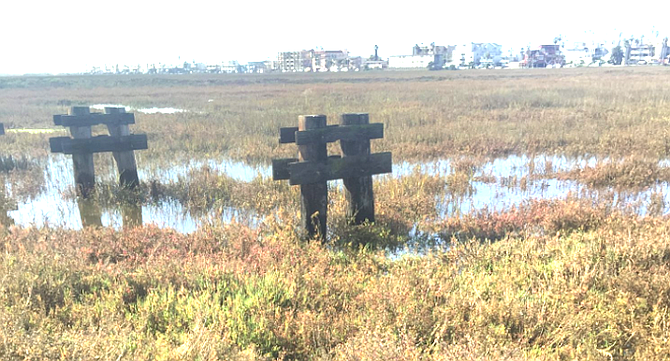
“You just got one [mosquito] that landed on your chest,” Sean Simmons said, “and there’s some flying around you.”
“Ohhh man there’s another mosquito on my shoulder,” I said as I swatted it away.
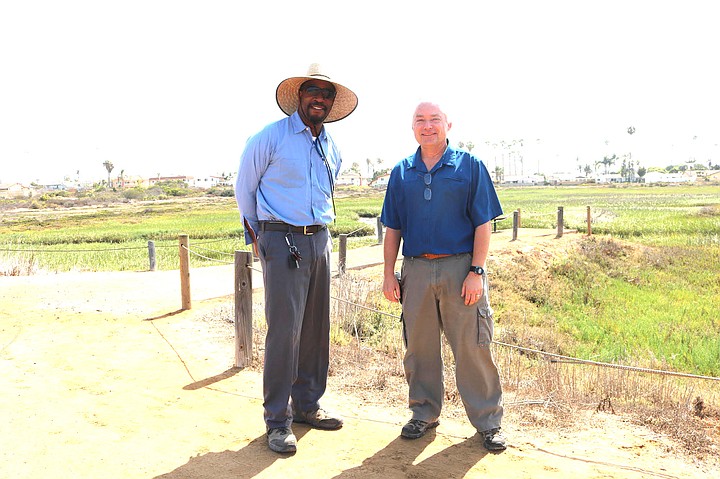
On August 3 at 10 am, I was bitten by over a dozen mosquitos at the Tijuana Estuary in Imperial Beach.
“Mosquitos are attracted to the carbon dioxide that you emit when you exhale,” Chris Conlan said. “That brings them into the area but once they are in the area, it's more secondary cues that take over and scientists don’t have all of that figured out yet. Some people emit certain odors that are a bit more attractive to mosquitos.”

Conlan, a supervising vector ecologist for the County of San Diego, and Simmons, a vector control lead technician; met with me close to the source of the recent swarms of mosquitos in IB. We rendezvoused in front of the estuary office by Caspian Way and 3rd Street a couple block south of Imperial Beach Boulevard.
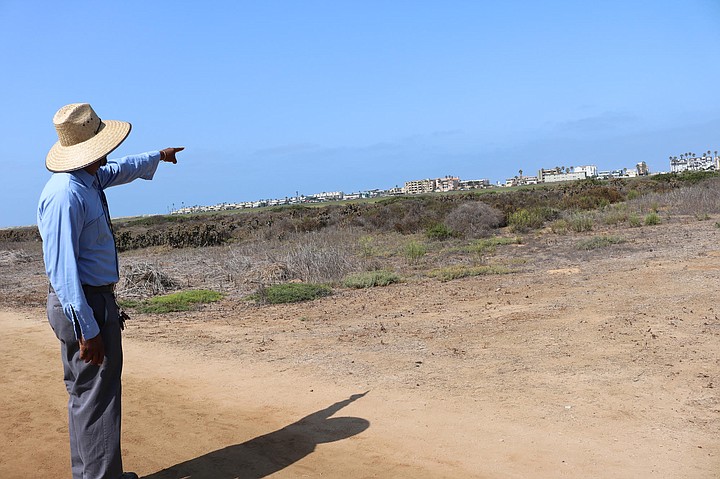
According to the estuary’s website: “The Tijuana Estuary is made up of freshwater from the Tijuana River that connects with the saltwater of the Pacific Ocean creating a large wetland habitat dominated by low lying vegetation known as a salt marsh.”
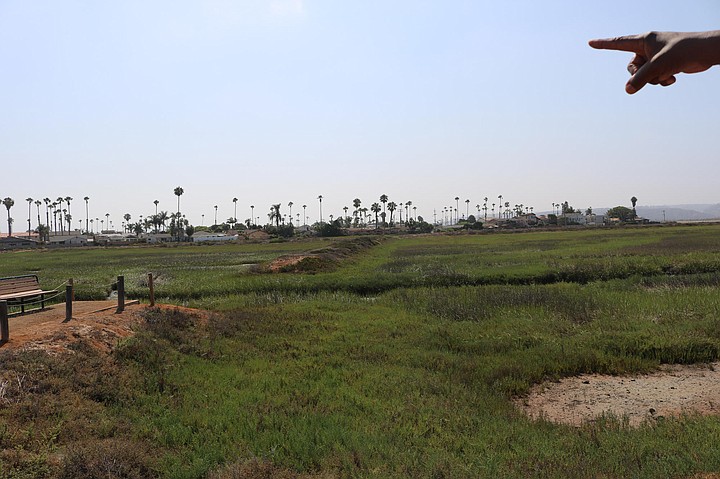
“You see those little brown things sticking up,” Simmons said as he pointed south of the estuary, “those are railroad ties.”
“Each one of those deep little holes around those railroad ties can breed thousands of mosquitos,” Conlan said, “in just that space around the railroad ties.”
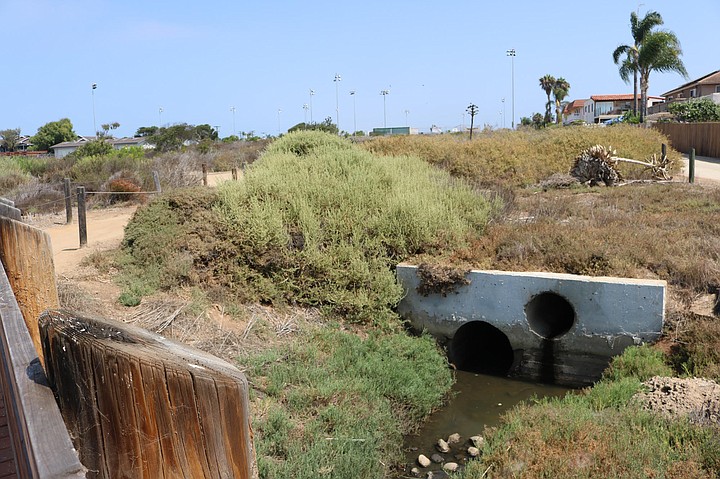
“I think they were going to build a railroad here a long time ago and they never got around to it,” Simmons said. “That’s about a quarter mile's worth.”
The two further explained that some of the railroad ties are immersed in water and by weeds, which are ideal locations for mosquitos to leave their larvae.
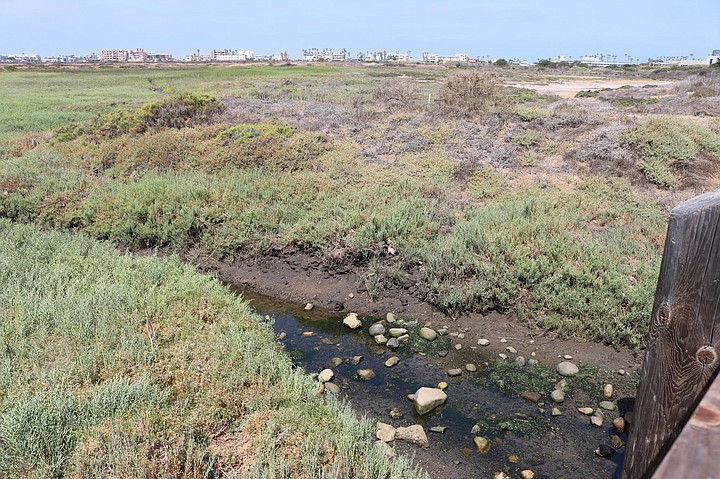
“Mosquitos like calm places to lay their eggs,” Conlan said, “they can tuck themselves in there and plus sometimes they’ll lay their eggs at the base of those weeds.”
“I wish I could show you,” Simmons said, “you look down in the water and you’ll see larvae everywhere.”
“I’m good for now,” I said, as I killed a mosquito that bit me on my neck.
On Seacoast Boulevard, which was about 200 yards to the west of us, there are catch basins and storm drains “where mosquitos breed as well.”
In the last month, many IB residents posted about their mass mosquito attacks on their social media.
“Crap, we are getting eaten alive on 2nd and Daisy Avenue,” said one; another neighbor confirmed: “same [here] on 2nd and Evergreen Avenue.”
Another resident was attacked about two miles east from the estuary. “I got bitten six times within seconds on 13th and Iris Avenue,” she posted.
Simmons posts up mosquito traps that are about three-four-foot long and cylindrical in shape — throughout IB.
“They are full of dry ice pellets and the cooler has a couple of holes drilled in it so when the ice gasses off, that’s what attracts the mosquitos,” Conlan said, “and directly below that cooler is a fan mechanism, and when the mosquitos come in to investigate, they get sucked into that fan mechanism and pushed down into a holding sock.”
When Simmons and his team capture the mosquitos, they bring them to Conlan and his team to analyze.
“These specific ones are called the Black Salt Marsh Mosquito, Conlan said. “They can go several miles; sometimes six-seven miles from where they are produced.”
“They are really annoying because they bite from sun up to sundown,” Simmons said.
“…. but the good news is they don’t transmit diseases,” emphasized Conlan, “including the West Nile Virus.”
The two attribute increase of the mosquitos to the heat and the recent king tides.
“Our guys do the best they can,” Conlan said. “You can see from the expanse that you are looking at, there is a lot of area and keep in mind is that it’s not a static habitat; things change over time. If you get an excessive high tide, it alters something a little bit and now all of a sudden there’s a new spot that shows up that’s breeding that wasn’t breeding before.”
“So what we’ll do is look at the habitat and see if there’s some mounds, berms or something like that, that can collect water,” Simmons said. “We’ll concentrate on those ….. and those railroad ties where they are down in the ground, it’s really deep right there 10-20 feet on each side; there’s water, especially on this side there’s a lot more water.
“Over here where that bridge is, there's an area there that holds water. Then there’s another area over there by that playground.”
The two said that the next high tide will come on August 10, the ideal time to treat the breeding areas.
“They (Simmons and his team) use a product that’s in a pelletized form,” Conlan said. “Those pellets have residual activity they put the stuff out there, it will slowly infiltrate into the water, and it continues to do that in a course of a few weeks.”
I then asked the two when will they spray the area next.
“We are not going to go out and spray the adult mosquitos,” Simmons said. “The more efficient way to deal with mosquitos is to kill them while they are in the larvae stage, because they are concentrated in the water ….. you can see them in the water, you can literally see thousands. We [strategically] place a (biological product) granule and it really starts to work in 24 hours and some even sooner.”
I met Mark later that morning by his house at Iris Avenue and 5th Street; he’s lived in the area for 60 years.
“Mosquitos have always been here,” he said, “back in the early 1980s they had a plane spray the whole place.”
“About two-three years ago it was so bad out that I inhaled mosquitos when I rode my mountain bike,” he said. “Earlier I saw people out there in the estuary, I think spraying or something. That’s kept it down a bit.”
Simmons talks to the hikers in the estuary and neighbors to assess the mosquito problems; he said in the last couple of days, his team received over 50 calls from IB residents. “For the past couple of years, the residents have been saying this is the worst it’s ever been,” he said.
“[And] we’ve been beefing up our staff steadily for the last few years,” Conlan said. “We brought in 15 temporary staff during the course of the summer so they can help out so we can stay on top of this stuff.”
On the county website, it lists various remedies to protect yourself from mosquito bites. “Apply insect repellent that contains DEET, Picaridin, IR3535 or Oil of Lemon Eucalyptus when you are outdoors. Whenever you use an insecticide or insect repellent, be sure to read and follow the directions carefully. Avoid applying repellent to children less than two years old. Use care in applying repellent on children; repellent on their hands may get into their mouth and eyes, causing irritation.”


“You just got one [mosquito] that landed on your chest,” Sean Simmons said, “and there’s some flying around you.”
“Ohhh man there’s another mosquito on my shoulder,” I said as I swatted it away.

On August 3 at 10 am, I was bitten by over a dozen mosquitos at the Tijuana Estuary in Imperial Beach.
“Mosquitos are attracted to the carbon dioxide that you emit when you exhale,” Chris Conlan said. “That brings them into the area but once they are in the area, it's more secondary cues that take over and scientists don’t have all of that figured out yet. Some people emit certain odors that are a bit more attractive to mosquitos.”

Conlan, a supervising vector ecologist for the County of San Diego, and Simmons, a vector control lead technician; met with me close to the source of the recent swarms of mosquitos in IB. We rendezvoused in front of the estuary office by Caspian Way and 3rd Street a couple block south of Imperial Beach Boulevard.

According to the estuary’s website: “The Tijuana Estuary is made up of freshwater from the Tijuana River that connects with the saltwater of the Pacific Ocean creating a large wetland habitat dominated by low lying vegetation known as a salt marsh.”

“You see those little brown things sticking up,” Simmons said as he pointed south of the estuary, “those are railroad ties.”
“Each one of those deep little holes around those railroad ties can breed thousands of mosquitos,” Conlan said, “in just that space around the railroad ties.”

“I think they were going to build a railroad here a long time ago and they never got around to it,” Simmons said. “That’s about a quarter mile's worth.”
The two further explained that some of the railroad ties are immersed in water and by weeds, which are ideal locations for mosquitos to leave their larvae.

“Mosquitos like calm places to lay their eggs,” Conlan said, “they can tuck themselves in there and plus sometimes they’ll lay their eggs at the base of those weeds.”
“I wish I could show you,” Simmons said, “you look down in the water and you’ll see larvae everywhere.”
“I’m good for now,” I said, as I killed a mosquito that bit me on my neck.
On Seacoast Boulevard, which was about 200 yards to the west of us, there are catch basins and storm drains “where mosquitos breed as well.”
In the last month, many IB residents posted about their mass mosquito attacks on their social media.
“Crap, we are getting eaten alive on 2nd and Daisy Avenue,” said one; another neighbor confirmed: “same [here] on 2nd and Evergreen Avenue.”
Another resident was attacked about two miles east from the estuary. “I got bitten six times within seconds on 13th and Iris Avenue,” she posted.
Simmons posts up mosquito traps that are about three-four-foot long and cylindrical in shape — throughout IB.
“They are full of dry ice pellets and the cooler has a couple of holes drilled in it so when the ice gasses off, that’s what attracts the mosquitos,” Conlan said, “and directly below that cooler is a fan mechanism, and when the mosquitos come in to investigate, they get sucked into that fan mechanism and pushed down into a holding sock.”
When Simmons and his team capture the mosquitos, they bring them to Conlan and his team to analyze.
“These specific ones are called the Black Salt Marsh Mosquito, Conlan said. “They can go several miles; sometimes six-seven miles from where they are produced.”
“They are really annoying because they bite from sun up to sundown,” Simmons said.
“…. but the good news is they don’t transmit diseases,” emphasized Conlan, “including the West Nile Virus.”
The two attribute increase of the mosquitos to the heat and the recent king tides.
“Our guys do the best they can,” Conlan said. “You can see from the expanse that you are looking at, there is a lot of area and keep in mind is that it’s not a static habitat; things change over time. If you get an excessive high tide, it alters something a little bit and now all of a sudden there’s a new spot that shows up that’s breeding that wasn’t breeding before.”
“So what we’ll do is look at the habitat and see if there’s some mounds, berms or something like that, that can collect water,” Simmons said. “We’ll concentrate on those ….. and those railroad ties where they are down in the ground, it’s really deep right there 10-20 feet on each side; there’s water, especially on this side there’s a lot more water.
“Over here where that bridge is, there's an area there that holds water. Then there’s another area over there by that playground.”
The two said that the next high tide will come on August 10, the ideal time to treat the breeding areas.
“They (Simmons and his team) use a product that’s in a pelletized form,” Conlan said. “Those pellets have residual activity they put the stuff out there, it will slowly infiltrate into the water, and it continues to do that in a course of a few weeks.”
I then asked the two when will they spray the area next.
“We are not going to go out and spray the adult mosquitos,” Simmons said. “The more efficient way to deal with mosquitos is to kill them while they are in the larvae stage, because they are concentrated in the water ….. you can see them in the water, you can literally see thousands. We [strategically] place a (biological product) granule and it really starts to work in 24 hours and some even sooner.”
I met Mark later that morning by his house at Iris Avenue and 5th Street; he’s lived in the area for 60 years.
“Mosquitos have always been here,” he said, “back in the early 1980s they had a plane spray the whole place.”
“About two-three years ago it was so bad out that I inhaled mosquitos when I rode my mountain bike,” he said. “Earlier I saw people out there in the estuary, I think spraying or something. That’s kept it down a bit.”
Simmons talks to the hikers in the estuary and neighbors to assess the mosquito problems; he said in the last couple of days, his team received over 50 calls from IB residents. “For the past couple of years, the residents have been saying this is the worst it’s ever been,” he said.
“[And] we’ve been beefing up our staff steadily for the last few years,” Conlan said. “We brought in 15 temporary staff during the course of the summer so they can help out so we can stay on top of this stuff.”
On the county website, it lists various remedies to protect yourself from mosquito bites. “Apply insect repellent that contains DEET, Picaridin, IR3535 or Oil of Lemon Eucalyptus when you are outdoors. Whenever you use an insecticide or insect repellent, be sure to read and follow the directions carefully. Avoid applying repellent to children less than two years old. Use care in applying repellent on children; repellent on their hands may get into their mouth and eyes, causing irritation.”
Comments